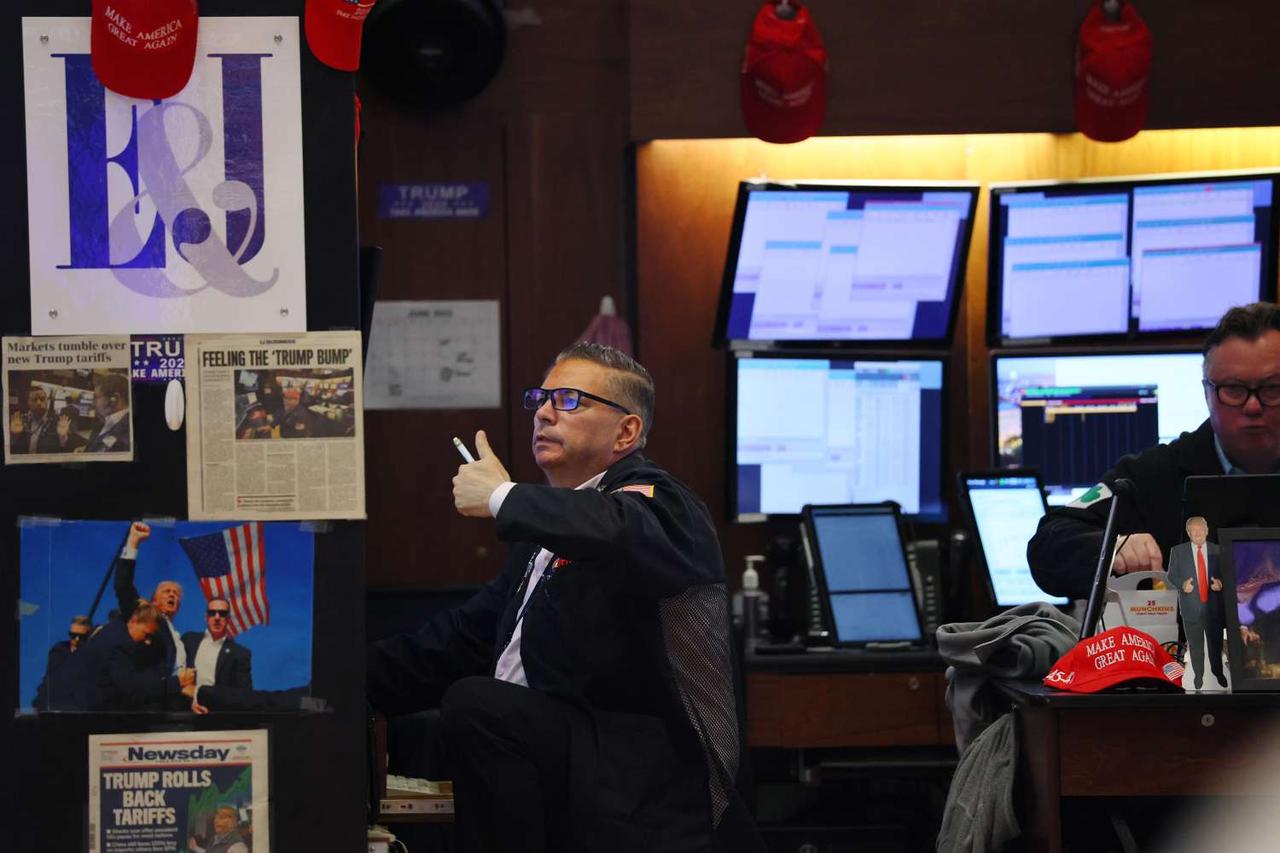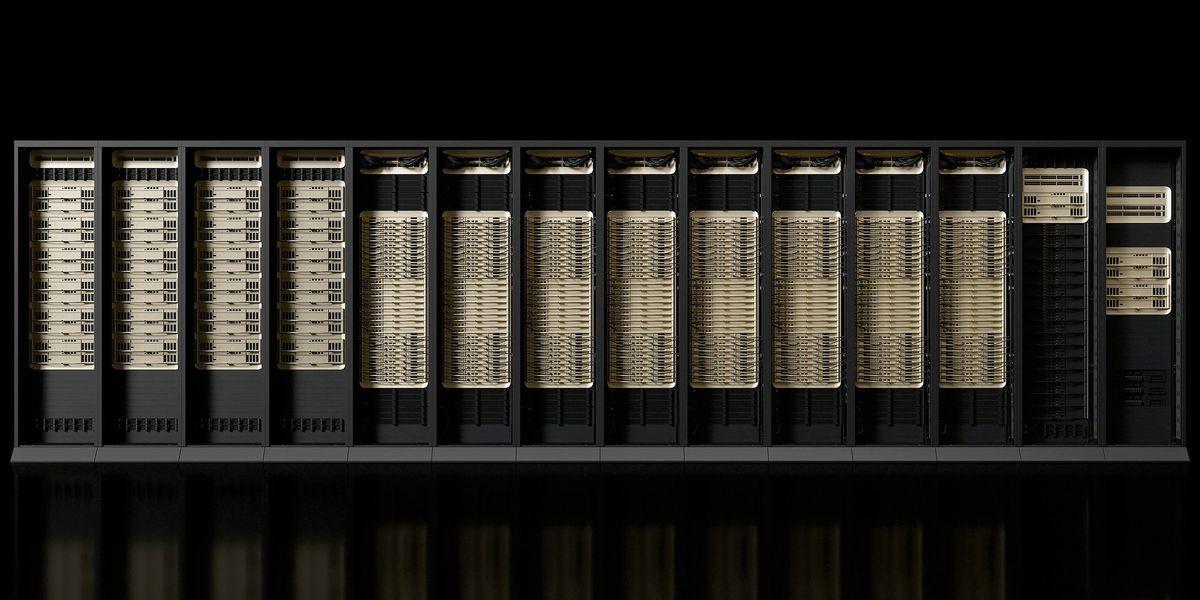AI Drives Stock Market to Record Highs in First Half of 2025
2 Sources
2 Sources
[1]
Stocks set new record to wrap up first half; here's what drove markets
Traders work the floor at the New York Stock Exchange. (Brendan McDermid/Reuters) The U.S. stock market ended the first half of 2025 with back-to-back record highs, defying a rollicking few months of trade tensions and economic uncertainty that sent it deep into negative terrain in April. The S&P 500, the widely followed index that underpins the retirement accounts of millions of Americans, sank into a deep correction after President Donald Trump announced sweeping tariffs, rattling financial markets in March and April. But momentum shifted over the next several weeks as the White House backed off its steepest tariffs. On Monday, the benchmark index closed at 6,204.95, up 0.5 percent, building on its record finish from Friday. It's now up 5.5 percent for the year. The tech-heavy Nasdaq composite index also ended 0.5 percent higher, to settle at 20,369.73, for its second consecutive record finish. It has gained 5.5 percent for the year. The Dow Jones Industrial Average climbed 0.6 percent, to 44,094.77, and has now advanced 3.6 percent year to date. The recent highs -- coming about 90 days after the last record in February -- mark "one of the quickest recoveries that we've seen in recent times," said Larry Adam, chief investment officer at Raymond James. Corporate spending on artificial intelligence continued to drive an outsize share of the gains, as companies in software and energy surged relative to the broader market. The market performance also reflects the fact that the economy hasn't slipped into a recession as many experts feared; corporate earnings remain strong, and the labor market has shown resilience, with joblessness near longtime lows. Nor has inflation run out of control: Prices rose 2.3 percent in May compared with a year ago, as Americans reduced spending for the first time since January, according to recently released federal figures. Still, some analysts see reason to be cautious. Consumer sentiment increased in June but is still down from December, according to the latest University of Michigan survey. The U.S. economy contracted more than previously estimated in the first quarter, according to revised GDP figures last week from the Commerce Department's Bureau of Economic Analysis, as consumers reined in spending. The dollar's value has slid to a three-year low, hurting Americans' purchasing power. "We're definitely seeing some trade down from higher-priced retailers, convenience stores, supermarkets, drugstores," said Loop Capital Markets senior equity analyst Anthony Chukumba, commenting on Dollar General, which increased more than 50 percent year to date. Dollar General likely also benefited from its low exposure to China and from competitors, such as Big Lots, closing stores or going out of business, he added. The U.S. consumer may not be spending like a "sailor ... on shore leave" as they do in good times, but they haven't stopped spending, said John Stoltzfus, Oppenheimer's chief investment strategist. "The consumer, when concerned about the economy as it pertains to employment prospects or the cost of money reflected in interest rates, tends to gravitate towards private label goods, discount stores and used cars," he said. Tech companies helped drive market gains. Shares of AI chipmaker and semiconductor companies Nvidia and Broadcom surged more than 17 percent and 19 percent, respectively, in the first six months of the year, while Intel grew 12 percent. Nvidia's growth is particularly noteworthy because the S&P 500 is weighted, meaning big companies such as Apple, Nvidia and Microsoft have outsize sway on its overall performance. The AI boom also extended to certain utilities and energy equipment stocks -- which are expected to benefit from AI data centers' electricity needs. NRG Energy soared more than 79 percent, while the gas-powered turbine manufacturer and service provider GE Vernova jumped about 60 percent. "We're suddenly seeing this incredible inflection in the amount of new power generation that the grid needs," said Austin Wang, a senior equity analyst at GLJ Research covering electrification industrials and infrastructure. "And while part of this is definitely a function of data center demand, it is not just AI but also organic," as operators swap out or service aging fleets, among other factors. The market rebounds came despite early-year concerns that AI and retail companies would tank amid competition from China and broader belt-tightening due to tariffs and high inflation. Tech stocks tumbled at the start of 2025, after DeepSeek -- an AI chatbot released by a Chinese start-up -- rocketed to the top spot in Apple's app store, stoking fears that U.S. companies were overspending on AI infrastructure that would not become profitable. DeepSeek initially "seemed to work awfully well -- it worked much more cheaply, and required less hardware to operate," said longtime stock analyst Ed Yardeni. But some of the hype around DeepSeek fell away, and U.S.-based tech companies continued to spend heavily on the sector, according to corporate earnings reports. "Tech companies have continued to invest. In fact, they are expected to actually increase their spending not only this year, but into next year," Adam said. The tech sector may have "started the year with its back against the wall," but "the mojo is back," Wedbush senior analyst Dan Ives said. Other tech companies outperformed the broader market. Shares of Palantir Technologies -- a data integration and AI company with many government contracts -- swelled more than 80 percent. Palantir recently said it would help develop software with a nuclear energy project development firm, as many countries are showing more appetite for the energy source, said Mark Giarelli, equity analyst for Morningstar. And the company separately said it would partner with Accenture Federal Services "to help federal government agencies reinvent operations with AI." Cryptocurrency exchange Coinbase Global grew more than 40 percent, much of that after Congress began advancing legislation that would add regulations around stablecoins, a kind of cryptocurrency value is tied to another asset such as the dollar. "This has been a transformational year for Coinbase, both in terms of its own platform and the environment in which the company operates," including a more crypto-friendly regulatory approach in the U.S. than in past administrations, said Mark Palmer, equity research analyst at The Benchmark Company. Still, not every tech stock did well -- a break from past years when a group of "Magnificent 7" tech stocks consistently outperformed the markets. Alphabet -- the parent company of Google, which has faced pressure from AI search tools such as ChatGPT -- Apple, and Tesla all ended the first half of the year down. Some Apple products could be affected by tariffs and the company's AI efforts have faced setbacks. Large-cap companies with insulated or flexible supply chains, or with enough capital to withstand the volatility of changing tariff policies, have also performed well, analysts said. Underperformers include automobiles, auto parts and consumer apparel with Asian manufacturing hubs -- sectors affected by tariffs that tend to be lower margin to begin with, Adam said. Lululemon Athletica has shed more than 37 percent year-to-date. The market has been buffeted by the administration's efforts to impose tariffs and negotiate other trade deals in recent months. An April plan to levy import taxes on dozens of countries was paused for 90 days -- set to expire by July 9 -- as negotiations continue. Canada on Sunday said it would rescind a planned tax on large tech companies after Trump threatened to suspend trade talks with Ottawa. Other tariffs have already been imposed on specific sectors, such as steel, aluminum, auto parts and imported cars. Analysts see significant uncertainty on the horizon for the second half of the year. Sam Stovall, chief investment analyst at CFRA, said both 2023 and 2024 ended in bull markets -- and few two-year bull markets turn into three-year runs. "The Kansas City Chiefs will be the first to tell you that three-peats are very hard to accomplish," he said.
[2]
These Stocks Soared in the First Half of 2025. Can They Keep It Up?
Colin is an Associate Editor focused on tech and financial news. He has more than three years of experience editing, proofreading, and fact-checking content on current financial events and politics. He received his M.A. in journalism from The New School and his B.A. in history and political science from McGill University. The stock market shook off one of its worst sell-offs in recent memory to finish the first half of 2025 on a high note. That's lifted stocks associated with AI, crypto -- and gold. How did we get here? It's been a ride. Stocks plummeted in early April after President Donald Trump unveiled sweeping global tariffs that threatened to scramble global supply chains, spike prices, and slow growth. Trump's subsequent pause of those tariffs, however, ignited a rally that was further fueled by benign economic data and easing trade tensions. By the end of June, stocks had rebounded to record highs. Wall Street's latest rally has looked a bit like last year's bull market. Artificial intelligence continued to connect many of the market's winners. But a few new themes have emerged amid the Trump administration's shake-up of the status quo. Here, we'll examine the stock market's leaders from the first six months of 2025 -- and examine how the forces underlying their gains could evolve in the next six. Crypto investors have been handsomely rewarded for the industry's spending on November's election. The industry last year spent more than $100 million in support of pro-crypto candidates. In January, the "most pro-crypto Congress" in history was sworn in and Washington wasted little time giving the industry what it wanted. Federal regulators have dropped pending litigation against cryptocurrency companies. Trump signed an executive order establishing a Bitcoin reserve. In May, the Digital Asset Market Clarity Act, which would establish a framework for the regulation of cryptocurrencies, was introduced in the House of Representatives. And the Senate in June passed the GENIUS Act, legislation that establishes rules governing stablecoins. That's helped grow the cryptocurrency market's value to more than $3.2 trillion. Washington's embrace, however, has also boosted related stocks this year. Robinhood (HOOD) stock more than doubled in price in the first half, while Coinbase (COIN) shares rose 41%. Circle Internet Group's (CRCL) shares more than doubled during the stablecoin issuer's first day of trading in early June; the stock rose nearly 750% in the two weeks after its debut. The cryptocurrency legislation working its way through Congress is expected to have little trouble making its way to Trump's desk for signature in the second half of this year. Trump and his family may continue feeding the industry's animal spirits with new crypto ventures. Analysts came into the year expecting the group of stocks considered emblematic of the AI trade to change. That has panned out to an extent. Leadership was expected to shift from AI infrastructure stocks -- companies like Nvidia (NVDA), whose chips fill the data centers that cloud computing giants like Amazon (AMZN) and Microsoft (MSFT) use to train and run AI models -- to software and services providers developing and monetizing AI applications. Palantir (PLTR) was the best-performing stock in the S&P 500 in the first half of the year; its impressive sales and earnings growth have been driven primarily by its AI software. Social media giant Meta Platforms (META) is the Magnificent Seven's best performer year-to-date thanks in part to its success introducing AI features that have improved performance metrics. Software stocks are expected to continue to outperform as they improve AI models and develop new applications. They could also benefit from their relative insulation from trade uncertainty, which dented the overall stock market's returns in the first half. AI infrastructure, a theme that outperformed for most of 2024, continued to be a winner on Wall Street in the first half of this year. Tech giants Microsoft, Amazon, Alphabet (GOOG), and Meta looked through economic uncertainty and stood by plans to cumulatively spend hundreds of billions of dollars on property, buildings, and equipment this year. Much of that spending is earmarked for the technology required to develop and run advanced AI, like Nvidia chips, Super Micro Computer (SMCI) servers, and Amphenol (APH) fiber optic cables. Those hardware suppliers saw their shares rise 18%, 61%, and 42%, respectively, in the first half. The buildout of power-hungry data centers boosted the stocks of nuclear power providers, whose electricity is in demand from tech companies who say they are looking to shrink their carbon footprints. Shares of Constellation Energy (CEG) and Vistra (VST) advanced 44% and 41%, respectively. But bringing new nuclear power online is a long process, and data centers are in the meantime relying on natural gas, boosting the stocks of gas-fired plant operators like NRG Energy (NRG), up 78% year-to-date, and gas turbine makers like GE Vernova (GEV), up 61%. Experts expect the AI infrastructure trade to be resilient. Tech giants "are planning for long-term data center capacity requirements and won't alter their investment plans based on tariff regimes that change from week to week," said Shaon Baqui, tech equities analyst at Janus Henderson Investors. The mood globally in the first half of 2025 was tense, to put it mildly. That was good for gold. In five months, the second Trump administration launched a global trade war targeting friends and foes alike; opened questions about America's commitment to longtime alliances like NATO; increased America's involvement in Israel's conflict with its neighbors; and ratcheted up tensions with China. Investors who sought stability turned to gold, a time-honored safe-haven asset. Gold prices climbed to record high after record high, peaking at more than $3,450 on June 13, the day Israel launched attacks on Iran's nuclear program. Shares of gold miner Newmont (NEM) followed prices higher, rising 56% over the first half of the year. Fellow miners Barrick (B) and Agnico Eagle Mines (AEM) advanced 34% and 52%, respectively. Central banks, wary of inflation and their reliance on U.S.-controlled reserve assets, have been major buyers of gold in recent years. Demand for gold is expected to remain high for the foreseeable future as governments around the world seek to hedge against elevated geopolitical tensions and an uncertain global economic outlook. The World Gold Council's most recent Central Bank Gold Reserves survey found that nearly all central banks expect global gold reserves to increase over the next 12 months. A record 43% of respondents said they plan to add to their gold holdings over the same period.
Share
Share
Copy Link
The U.S. stock market reached new records in the first half of 2025, with AI-related companies leading the surge. Despite initial trade tensions and economic uncertainty, the market rebounded strongly, driven by continued corporate investment in AI technology and infrastructure.
Stock Market Reaches New Heights
The U.S. stock market concluded the first half of 2025 with back-to-back record highs, overcoming a tumultuous period marked by trade tensions and economic uncertainty. The S&P 500 closed at 6,204, up 5.3% for the year, while the tech-heavy Nasdaq composite index settled at 20,369, gaining 5.7%
1
. This remarkable recovery came just 90 days after the last record in February, representing one of the quickest rebounds in recent times.
Source: Investopedia
AI Drives Market Gains
Corporate spending on artificial intelligence (AI) continued to be a significant driver of market gains. Tech companies, despite early-year concerns, maintained and even increased their investments in AI infrastructure and development. This trend benefited not only software companies but also hardware suppliers and energy providers.
Nvidia and Broadcom, key players in AI chip manufacturing, saw their shares surge by more than 17% and 19% respectively in the first six months of the year
1
. Palantir Technologies, a data integration and AI company, experienced an impressive growth of over 80%2
.Energy Sector Benefits from AI Boom
The AI boom extended its influence to the energy sector, particularly benefiting companies involved in powering data centers. NRG Energy saw a remarkable 79% increase in stock value, while GE Vernova, a gas-powered turbine manufacturer and service provider, jumped about 60%
1
. This surge was attributed to the increasing demand for electricity to power AI data centers.Cryptocurrency and Regulatory Changes
The cryptocurrency market also experienced significant growth, with its total value exceeding $3.5 trillion. This expansion was partly due to favorable regulatory changes, including the introduction of the Digital Asset Market Clarity Act and the passage of the GENIUS Act in the Senate
2
. These legislative developments boosted crypto-related stocks, with Robinhood and Coinbase seeing substantial gains.Economic Factors and Consumer Behavior
Despite the overall market growth, some economic indicators suggested caution. The U.S. economy contracted more than previously estimated in the first quarter, and consumer sentiment, while improved in June, remained below December levels
1
. This economic uncertainty led to changes in consumer behavior, with a trend towards private label goods, discount stores, and used cars.Related Stories
Global Tensions and Safe-Haven Assets
The first half of 2025 was marked by global tensions, including trade wars and geopolitical uncertainties. These factors contributed to the rise in gold prices, as investors sought stability in this traditional safe-haven asset
2
.Looking Ahead
As the market enters the second half of 2025, analysts expect the AI infrastructure trade to remain resilient. Tech giants are planning for long-term data center capacity requirements, which are unlikely to be significantly altered by short-term changes in tariff regimes. The continued growth in AI applications and the potential for further regulatory clarity in the cryptocurrency market may continue to shape market trends in the coming months.
References
Summarized by
Navi
[1]
Related Stories
Recent Highlights
1
X's Paywall Doesn't Stop Grok From Generating Nonconsensual Deepfakes and Explicit Images
Policy and Regulation

2
Nvidia Vera Rubin architecture slashes AI costs by 10x with advanced networking at its core
Technology

3
OpenAI launches ChatGPT Health to connect medical records to AI amid accuracy concerns
Technology








